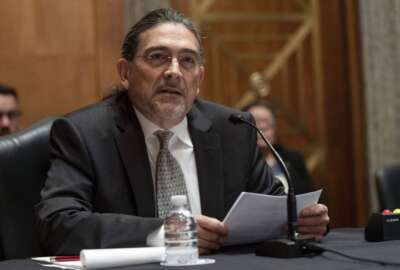Labor, OPM, Census dialing up AI tools to crunch data, improve mission outcomes
More than two dozen agencies have posted their artificial intelligence use case inventories as required by an executive order and by law.
The Labor Department is using artificial intelligence to make worker’s compensation forms more accurate.
The Census Bureau has turned to AI to crunch massive datasets.
And the Office of Personnel Management is applying AI to updating 30-plus year old positions descriptions.
Agency chief information officers say these and many other AI mission-focused uses cases are not only demonstrating the promise of the technology, but, maybe more importantly, selling the agency more broadly on how they can apply AI to solve problems.

“We are also investing in responsible AI frameworks. Krista Kinnard, in my emerging technology branch, is collaborating with Stanford University and others to build frameworks so that it’s not one and done. We often are susceptible to the ones and done mentality. Just give me this new app and I don’t want to see you again for a few years. And that has to change in many ways,” said Gundeep Awhluwalia, the chief information officer at the Department of Labor, during a panel at the recent GITEC Summit, an excerpt of which played on Ask the CIO. “We have deployed artificial intelligence and machine learning in various processes. One example where we’ve used it very successfully is to auto code Occupational Safety and Health Administration’s (OSHA) injuries. So when injuries are reported, these have to be coded in order to understand what is happening from an injury perspective. Today, 97% of these are now auto coded using machine learning and 3% to 4% have to be flagged for humans to intervene. We have tried to use these technologies to push humans from low value work to high value work.”
The OSHA example is one of 18 AI uses cases Labor detailed in its inventory posted earlier this year. Several focus on using natural language processing and machine learning tools to better extract and understand large data sets.
Census applying AI to survey data
Tackling large datasets is a common theme among agencies.
‘Skip’ Bailey, the deputy chief information officer of the Census Bureau in the Department of Commerce, said the two big areas where AI and machine learning are having an impact is with survey and other data it regularly collects.
“There’s a lot of interesting work that’s been done on doing that with some machine learning models that help to crunch through these massive datasets. The other side of it is actually for live chat programs,” he said. “They’re essentially crawlers and they get their data by crawling but the attribution of the correct or the best source is not always included and so it’s actually become incumbent on us to become the most obvious choice for the crawlers. You have to play that game so that your data is the one when someone asks a question because we see stuff come up and we’ve actually done studies where there’s data, but it’s really our data and it’s been reported incorrectly by a third party.”
The Census is making sure chatbots are coming to its data first and making it easier to find their data to ensure there isn’t any misinformation being shared.
Across Commerce, there are 50 use cases in its AI inventory, though none are Census led.
Some of the examples in the inventory includes 30 by the National Oceanic and Atmospheric Administration (NOAA) for everything from measuring volcanic ash in the air to a machine learning tool to estimate probability of excessive rainfall. The US Patent and Trademark Office and the International Trade Administration also have several use cases where they are putting AI to work around mission areas.
OPM to update position descriptions
Over at the Office of Personnel Management, the AI use cases are just a few focusing on everything from the retirement services chatbot and skills matching for open jobs.
Guy Cavallo, CIO of the Office of Personnel Management, said a new use case will use AI to update position descriptions.
“We’re just launching a pilot, that I think every agency’s going to want us to be successful, around federal employee position descriptions. Show me anybody, anybody that wants to rewrite from the 1980s a position description today?” he said. “We’re going to experiment with AI on coming up with good position descriptions because the human way of doing it across the federal government is not succeeding.”
The December 2020 executive order on promoting trustworthy AI and the Advancing AI Act passed in December, mandated agencies publicly provide these AI uses case inventories.
Since June 2022, 25 agencies published their AI use case inventories, detailing hundreds of ways they are using this emerging technology.
While each agency lists the data around their uses cases slightly differently, most include a name and a summary of the work being done.
The White House says publishing the use cases serves two purposes. First, it provides transparency to the public. Second, it help agencies identify similar AI use cases across the government to make it easier to share and re-use methodologies, technologies and best practices.
Copyright © 2025 Federal News Network. All rights reserved. This website is not intended for users located within the European Economic Area.
Jason Miller is executive editor of Federal News Network and directs news coverage on the people, policy and programs of the federal government.
Follow @jmillerWFED







